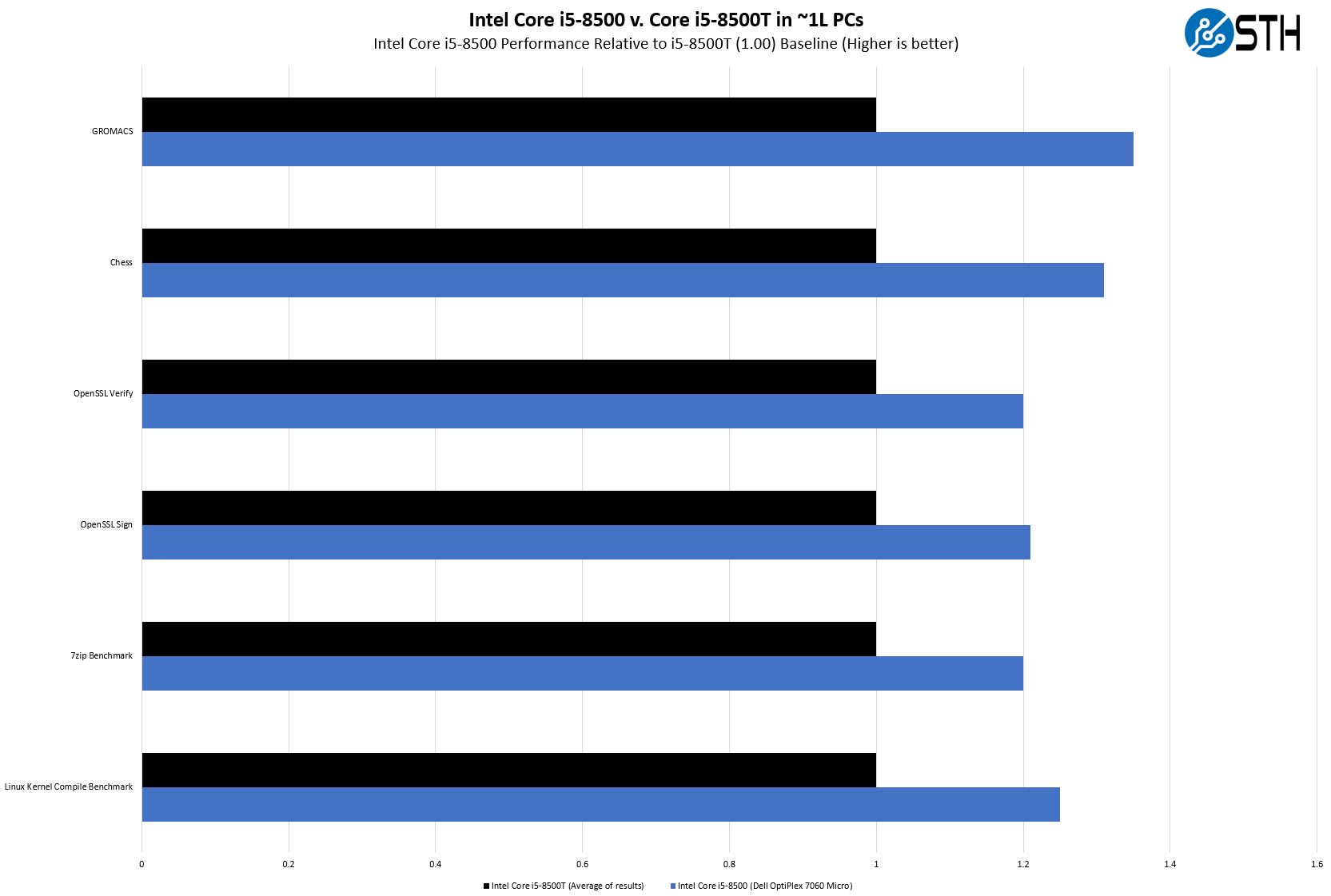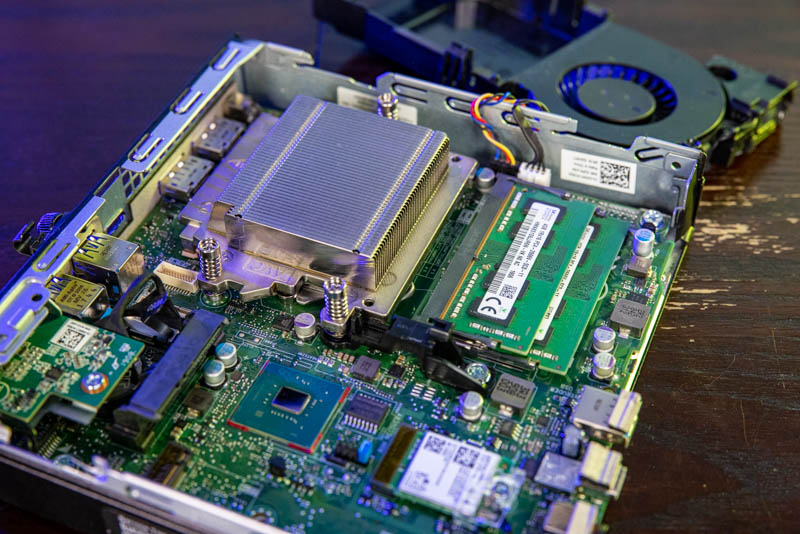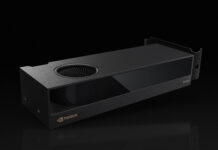Key Specs
Since many of our users are going to want to run different OSes on this, we wanted to give some of the key hardware specs. There is a lot on these machines that are customizable, but this at least gives you some sense of what hardware is available. If you want to know if your hardware is compatible with your OS, this list should help do that tie-out.
CPU Support
Here are the officially supported CPUs for the OptiPlex 7070 Micro:
Intel Core i3-8100 (4 Cores/ 6 MB/ 4T/ up to 3.6 GHz/ 65 W)
Intel Core i3-8300 (4 Cores/ 8 MB/ 4T/ up to 3.7 GHz/ 65W)
Intel Core i5-8400 (6 Cores/ 9 MB/ 6T/ up to 4.0GHz/ 65 W)
Intel Core i5-8500 (6 Cores/ 9 MB/ 6T/ up to 4.1GHz/ 65 W)
Intel Core i5-8600 (6 Cores/ 9 MB/ 6T/ up to 4.3 GHz/ 65 W)
Intel Core i7-8700 (6 Cores/12 MB/ 12T/ up to 4.6 GHz/ 65 W)
Intel Core i3-8100T (4 Cores/ 6 MB/ 4T/ up to 3.1 GHz/ 35 W)
Intel Core i3-8300T (4 Cores/ 8 MB/ 4T/ up to 3.2 GHz/ 35 W)
Intel Core i5-8400T (6 Cores/ 9 MB/ 6T/ up to 3.3 GHz/35 W)
Intel Core i5-8500T (6 Cores/ 9 MB/ 6T/ up to 3.5 GHz/ 35 W)
Intel Core i5-8600T (6 Cores/ 9 MB/ 6T/ up to 3.7 GHz/ 35 W)
Intel Core i7-8700T (6 Cores/ 12 MB/ 12T/ up to 4.0 GHz/ 35 W)
For the 65W parts, this system would use the 130W power adapter. For the 35W CPU, these systems use a 90W power supply.
RAM Support
- Up to 32GB in 2x DDR4-2400/ DDR4-2666 SODIMMs
Note: STH tested 2x 32GB Samsung SODIMMs and found the system can operate with 64GB of memory but this is not officially supported.
Storage Support
- 2.5″ SATA with Bracket
- M.2 PCIe for NVMe SSDs
Networking (Wired)
- Intel i219-LM
WiFi Support (Optional)
- Qualcomm QCA61x4A Dual-band 2×2 802.11ac Wireless + Bluetooth 4.2
- Intel Wireless-AC 9560, Dualband 2×2 802.11ac Wi-Fi with MU-MIMO + Bluetooth 5
Chipset
- Intel Q370 PCH
USB Ports
- 1x USB 3.1 Gen1 Front
- 1x USB 3.1 Gen2 Type-C Front
- 4x USB 3.1 Gen1 Rear
OSes From Factory
- Windows 10 Home (64-bit)
- Windows 10 Pro (64-bit)
- Windows 10 National Academic (64-bit)
- Ubuntu 16.04 SP1 LTS (64-bit)
- Neokylin v6.0 SP4 (China only)
The OS section can be a big deal. Sometimes the units are advertised as supporting Windows 10, but one gets a Windows 10 Home license. If you want to, or may want to, run Windows 10 Pro, knowing exactly which OS is on the device is ultra important. If you are running Linux or another OS, then it is nice to have the Ubuntu option from the factory since that means there was testing done on Linux.
Note: These systems sometimes change specs mid-generation. If you find another spec sheet with items you think we should add, please let us know in the comments.
Next, we are going to look at the performance and power consumption before getting to our final words.
Dell OptiPlex 7060 Micro Performance
Since we have a fairly good grasp of the Core i5-8500T having tested it in a number of different systems, we wanted to do something a bit different here. We wanted to compare this Dell OptiPlex 7060 with the 65W Core i5-8500 to the results we have with the 35W Core i5-8500T. A key question we want to answer is whether the upgrade to 65W is worth it.

Given what we saw with the sample above, and this extended to several benchmarks we do not publish as well, we get about 20-25% more performance than with the “T” version of the chip in these smaller systems. There are a few areas that hit specific execution paths that we are seeing more in the 25-35% better range.

There are a lot of variables here, so we specifically used the average of the other 1L systems as our Core i5-8500T data point so that we were not tied directly to a vendor, but our runs on that chip in the 35W systems are generally within a +/-2% variance so it did not make much of a difference.
Some may want this additional performance. At the same time, there are trade-offs in aspects such as power and fan speeds which have an environmental impact to get that extra performance.
Next, we are going to discuss power consumption before getting to our final words.




Great Review, you caught all the highlights! I am jealous of the equipment & pricing you find, but definitely could not handle your workload. I know this is a lot of work & passion with you, so thank you for all you do for your STH community. Best Regards, ABQ (Steve:)
I hope you posted suitable and detailed feedback for the online seller who shipped the unit with a power supply that was not compatible and then refused to fix the error. I personally think such a business practice is unethical and the seller should suffer consequences. One thing is to make a mistake; it’s another to make a business practice out of not fixing those mistakes.
As I don’t believe such business practices are common (at least in the United States) and so others don’t accidentally buy from the same seller, who was the seller?
Ebay would take your side if you want to return it.
Saying “dell power supply” is meaningless if it flat out -cant- be used with the product.
Great review. I happen to have two of these collecting dust. Could I replace the M.2 wifi/bt with a gigabit ethernet?
In several of your Mini/Micro videos, you mention the difference between network chipsets when discussing model differences. The explanation provided is a bit vague. One important difference is VLAN/QOS support. The Intel chipset supports VLAN/QOS. Cheaper chipsets may not. Although this probably isn’t important for anyone using the system as a desktop, home server enthusiasts might get some use out of this feature.